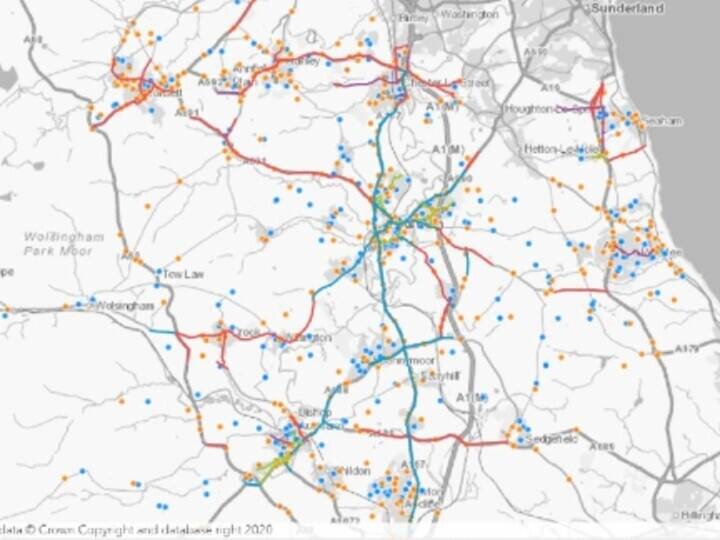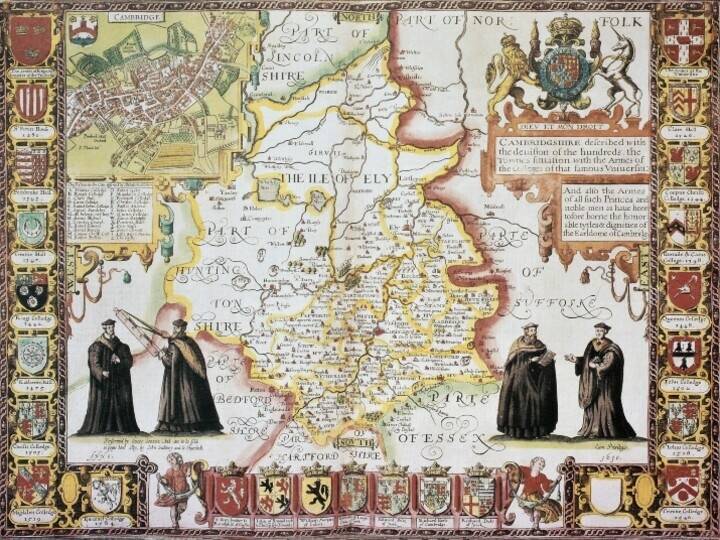Linking people and places - case study from London Borough of Lewisham for GeoPlace Exemplar Awards 2018
Every property in Great Britain has a Unique Property Reference Number (UPRN). The UPRN can provide a robust, link to integrate all manner of datasets, accurately and with confidence. Likewise, every street has a Unique Street Reference Number (USRN). Adding the UPRN and USRN to other datasets can help add value to information.
In the London Borough of Lewisham, a wide-ranging portfolio of projects shows the breadth of change that’s possible when UPRNs are at the heart of an improvement plan. Saving money, working towards Government targets, generating income and addressing residents’ needs:
• transforming residents’ household refuse collection and recycling habits with a UPRN-driven portal
• covering the operating costs of the borough’s street naming and numbering service
• managing Lewisham’s multi-departmental assets with more consistency and increased efficiency where assets are identified by linking them to UPRNs.
• providing colleagues and residents with a system interface that’s intuitive and easy to use, referencing properties and their needs on an individual basis
• streamlining the processes associated with the area’s land terrier and improving responses to enquires
• improving processes and outcomes in a range of departments that previously depended on manual intervention for data currency and accuracy.
Refuse collection
UPRNs are the driving force behind a residents’ portal that is transforming household recycling and refuse collection habits.
Changes to residents’ behaviour can lead to savings in the cost of living and improvements in lifestyle and health. With this in mind, the Government has set a target to recycle and compost 50% of all household waste by 2020.
Working towards this target, in 2017 Lewisham rolled out its new borough-wide recycling and refuse service. Collections were rescheduled from weekly to fortnightly, and an online refuse-request and subscription service was introduced.
By linking its properties’ UPRNs to collection routes, Lewisham can now ensure pin-point accuracy and efficiency in organising collections. Refuse, recycling, food waste and, if residents subscribe to the service, garden waste may be collected on the same day.
finding places
The team had to make sure all of its new refuse and recycling schedules were linked accurately to Unique Property Reference Numbers (UPRNs) and Unique Street Reference Numbers (USRNs).
This was a significant undertaking. As one of 35 major centres in Greater London, Lewisham has approximately 1,600,000 UPRNs
With around 100 regular refuse collections in its new schedule, and about 3,000 addresses on an average in each collection, this equated to approximately 600,000 round/address records.
Full details of the new collection rounds were made available via an online portal. By entering a postcode and choosing an address, residents initiate an API call to the Local Land and Property Gazetteer (LLPG) database. This returns information at an individual property level, enabling residents to plan for collection dates with ease.
achieving results
By using UPRNs to link residents with their refuse and recycling collections, the London Borough of Lewisham is achieving several of its goals:
• an increase in recycling rates: Lewisham is well on its way to meeting Government targets
• a reduction in the cost of refuse and recycling collections for the borough, with projections of £500,000 in savings each year
• increased resident satisfaction: in Lewisham’s 2015 consultation, 67% of residents asked for a food waste service and 94% thought it was important to recycle more.
Street naming and numbering service
The borough has been investing in development and regeneration work. As a result, planning and construction had an impact on street naming and numbering, which, in turn, impacted residents and service providers in the area.
Historically, the council had not sought to recoup any of the costs associated with its street naming and numbering (SNN) services. However, it began to see a marked increase in the activity as work increased.
The amount of paperwork involved meant the manual process was time-consuming and open to administrative errors. This put pressure on the team involved, and reduced satisfaction levels for the service’s users.
It was decided to create a new, online system, using UPRNs to ensure greater accuracy and efficiency.
Finding places
Lewisham’s new street naming and numbering system (the SNN system), is directly linked to UPRNs in the Local Land & Property Gazetteer and the National Land & Property Gazetteer.
This ensures data integrity for the team, with the SNN system’s intelligent online forms taking their feeds directly from the SQL database.
In addition, the new SNN system was designed to include extensive reporting functionality that would enable the team to generate UPRNs in matter of few minutes.
Achieving results
With every part of the SNN system now being digitised, and UPRNs linking requests with outcomes, errors have been reduced and the process has been speeded up.
Income generated now covers not only the new SNN system, but also the cost of SNN officer posts.
Asset management system
Lewisham’s Regeneration & Asset management team comprises around 100 colleagues working in different departments, using a wide range of systems, drives and spreadsheets.
The teams involved agreed: too much paperwork was being generated and they did not have access to data they needed, to manage assets efficiently.
Inevitably, this approach was delivering little or no consistency. The asset register itself had become incomprehensible, as it comprised a list of addresses that weren’t linked to any one, central system or dataset, and the cost of maintaining this less-than ideal system was in the region of £30,000 per annum.
Finding places
A new Asset Management System was created – Lewisham’s ‘AMS’. This system was configured so that different teams could manage Lewisham-owned and managed assets of all kinds, ranging from schools and buildings to highway artefacts.
Every asset in the system was linked using the UPRN as the basis for a unique identifier in the system. All of the UPRN references were also linked to respective USRNs, as the AMS also holds the Highways Asset Register.
Together, the UPRNs now link four different modules within the AMS, thereby ensuring the integrity of many different processes and workflows.
Achieving results
After implementation, previous asset-management costs of £30,000 per annum were eliminated and Lewisham’s AMS started to deliver significant savings. The teams also saw a significant reduction in paperwork, as all of their processes and workflows were digitised. The new system is accessible by a much wider group of colleagues, as its governance is maintained by an internal hierarchy – and every team can now manage asset-related projects and programmes with confidence.
UPRNs - linking people and places
How do UPRNs help residents?
Residents in the Lewisham borough can make requests and log jobs online by verifying a relevant address, using a UPRN that’s pulled from the LLPG.
The website makes an API call to the Local Land & Property Gazetteer (LLPG) / National Land & Property Gazetteer (NLPG), which brings up a list of confirmed addresses.
How do UPRNs help colleagues?
Lewisham has deployed a Rapid Address Finder tool on its intranet – a user-interface that verifies UPRNs and addresses directly from the LLPG/NLPG in real time.
This is available to every colleague who can log in to the Lewisham intranet, making it invaluable for team members who are also working remotely.
How do UPRNs help results?
As Lewisham’s Customer Services team takes calls, team members log the event on an internal Customer Relationship Management system.
Each event is linked to a UPRN in real time, making sure the event’s location is recorded accurately and efficiently.
The system’s interface is intuitive and easy to use, referencing properties and residents’ needs on an individual basis.
Digitising the land terrier
The London Borough of Lewisham’s land terrier is a record system for recording details of council-owned land and property.
It differs from HM Land Registry, in that the terrier is maintained for Lewisham’s own needs. It can’t be readily accessed by the public. It serves to ensure the council’s assets are maintained effectively for residents’ benefit.
Historically, the land terrier has existed in a manual format supported by a range of disparate systems. Documents, card files and boxes at the council’s offices occupied a great deal of useful space, and the de-coupled data silos made it difficult to process requests efficiently. The system was described as ‘clumsy’ and ‘time-consuming’. For users of the system, data accuracy had become a problem.
In addition, a significant amount of the land terrier’s archive was in a paper format and the risk of losing this information, due to fire or flooding, was unacceptably high. It became imperative to digitise the terrier entirely.
Finding places
Lewisham wanted a new land terrier application that would fully integrate with the council’s existing gazetteers, online geospatial information systems, data stores and general infrastructure.
It was decided that the application should use UPRNs as the link between these systems:
• designing the new land terrier to include web forms that would link directly to source UPRNs
• incorporating new HM Land Registry polygons to the Local Land & Property Gazetteer’s spatial database; converting them to intelligent records that would then link to UPRNs.
• cross-referencing the HMLR polygons with the LLPG polygons for spatial referencing and compatibility, thus confirming UPRNs for the majority of HM Land Registry-sourced data
• cross-referencing plan references with UPRNs in the gazetteer and Title references possible
• configuring a Web GIS project and layers to display, report and allow capturing of Land Terrier tenure polygons linked to UPRNs.
Achieving results
By using the UPRN as the link between data sources, the new land terrier should deliver huge efficiencies for Lewisham, and reduce a major risk – thus helping the borough to support its residents with a system fit for the future.
Getting the most value from UPRNs
Within the borough council, several teams are still working without fully-digitised systems. Hard copies of registers and spreadsheets have to be checked and updated by hand. This creates room for error, it is an unwieldy system for colleagues to maintain, and delivers a less than ideal service to residents.
The Support for Troubled Families team’s work is a good example: colleagues work with information corresponding to over 22,000 people’s details.
The team has to match data from the Local Land & Property Gazetteer (LLPG) to information from at least 15 other sources before it can start analysing data with confidence - including information from the Department for Work & Pensions, the Ministry of Housing, Communities and Local Government, Department of Social Security, and the Department for Education. At least one of the data sets in use by this team comprises in excess of 800,000 individual records.
Finding places
Historically, the Support for Troubled Families team did not have access to data in the LLPG Gazetteer. However, by working collaboratively, an internal process has been agreed to provide UPRNs as and when required.
The team can now link extensive data sets together, with confidence. With an information sharing agreement securely in place, for example, the DWP can share appropriate data to advise on the UPRNs of families known to be eligible for work-related benefits. This has reduced the time taken significantly as it involved thousands of children’s data.
A similar exercise is being undertaken by the borough’s Public Health department. When the team has to communicate updates, reminders or alerts to parents and guardians of pupils within the Lewisham Borough, UPRNs now provide the robust link between data records in one department and information in another.
Achieving results
UPRNs provide a robust link between all kinds of datasets. In the London Borough of Lewisham, the adoption and use of UPRNs as its reference point is making a significant difference to the council’s performance – working towards Government targets and meeting residents’ needs.



